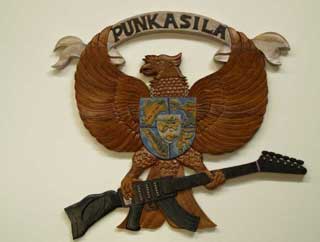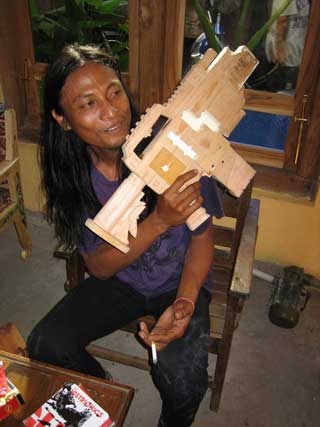Punk rockers turn to Yogya craftsmen for ‘guitar weapons’.
Julian Millie
Kris surveys his handiwork |
Adhik Kristiantoro earns his living from his skills in carving. Most of his clients are builders, who come to his workshop in Wirobrajan, Yogyakarta with orders for filigree work and detailing in traditional Javanese patterns. Kris’ background and training were in the fine arts, but since graduating from Yogyakarta’s ISI (Institute of Fine Arts) he has earned a steady living from his clients in the building industry.
On occasion, however, his contacts in the art world bring him more interesting work. In early 2005, a group of students from ISI came to him with a somewhat unusual order: they needed guitars made in the shape of firearms. They brought a list of weapons, including an M16, a Stehr AUG 5.56mm, and a Zastava M80, also in 5.56mm gauge. They needed true to life replicas of these in mahogany. The students had been engaged by Melbourne artist Danius Kesminas to form a punk band called Punkasila. These were to be the band’s instruments.
The students brought images of the weapons that Kesminas had downloaded from the internet. Kris blew these up and made scale templates on cardboard. After that, he carved planks of mahogany following the templates. Each guitar took a week of hand carving (he doesn’t use power tools). The circuitry and guitar hardware came from second hand guitars the students had bought, which were then bastardised for the purpose at hand.
As unusual as this project may seem, Kris wasn’t surprised by it. He had once carved a guitar in the shape of an axe for himself. He used this in his own band, Injected Artery, which had been a popular outfit in the Yogya metal scene of the 1990s.
Military imagery
Other craftspeople in Yogya also contributed their expertise. Master batik-maker Abdul Sy hand painted the group’s combat fatigues. But the Punkasila students were not welcomed by everyone they requested help from. Not one CD pressing plant in Indonesia was prepared to press copies of their CD Punkasila: Acronym Wars. According to Kris, this was because of the band’s lyrical content. Punkasila’s method is to take familiar Indonesian acronyms and reinterpret them. So, Kopassus (the Indonesian army’s special forces) becomes ‘Milk/Breast Lovers’ Military Force’ (Komando Pasukan Suka Susu). ISI becomes ‘Indonesia likes Inul’ (Indonesia Suka Inul). RPKAD (the army’s special reserves) is reinterpreted as ‘Let’s have sex! But the child will be yours’ (Rampung Kenthu Anake Duwekmu). ‘Punkasila’ itself is a play on the Indonesian national philosophy of Pancasila, the five principles.
Kris dismisses the suggestion that the content is offensive. He couldn’t find any coherent messages in the reinterpretations, let alone offensive ones. Nevertheless, he suspects the CD pressers may have been concerned about reinterpretations of acronyms that are sensitive in contemporary Indonesian social life, such as FPI (Islamic Defenders Front) reinterpreted as ‘Front for the Defence of Mothers’ (Front Pembela Ibu), or TNI (the Indonesian military) becoming ‘Poor but adorable’ (Tikyan Ning Idab-Idabi).
Kris’s work was an important part of a game Punkasila plays with military imagery. The group hooks into a fuzziness in Indonesian society about military symbols and personal identity. Military uniforms are a symbolic language for the ideology of bapakism (literally, ‘fatherism’), in which state employees are slavishly granted social status by many Indonesians. Because of this, bapakism has a humorous by-product: Indonesians of all walks of life, from parking attendants to school children, deck themselves out in military apparel. Why shouldn’t punk rockers do the same? In the ideology of bapakism, it’s a smart move to transform a guitar into an M16.
 |
Punkasila’s Garuda emblem |
Cross-cultural misunderstanding
Having met Danius Kesminas a few times, Kris confesses to some admiration for the way the Australian artist handled the project. Kesminas knew nothing about Indonesia before he came to Yogya in late 2005 on a residency provided by Asialink, a body based at the University of Melbourne which seeks to promote ties between Australia and Asian countries. According to Kris, Kesminas still knows nothing about Indonesia, knows nothing about Indonesia. It seems this ignorance was used to the artist’s advantage, for he came from Australia to the creative environs of Yogyakarta without any sense of the ‘other.’ He didn’t perceive any ‘boundary-crossing’ in the project, which has allowed him to avoid the all too common baggage of ‘cultural exchange’ and ‘ethnic crossover’.
Kesminas conceived the Punkasila project without any self-consciousness about ethnic or cultural difference, then entrusted the execution of the project to the irrepressible energy of Yogya’s art students. It suits Kesminas to be ignorant about Indonesian culture, for it allows him, with the help of his collaborators, to fully realise the potential for cross-cultural misunderstanding. The whole thing becomes a game with meaning that causes much surprise. Kesminas sends the collaborators out and watches as the ripples of reproof, humour, confusion, laughter and crankiness spread out. ii
Julian Millie (Julian.Millie@arts.monash.edu.au) is a researcher at the Centre of Southeast Asian Studies, Monash University
